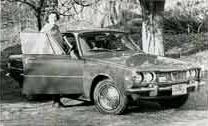On Thursday last, the production lines at MG Rover Group‘s automobile factory in Longbridge, on the southwest side of Birmingham, England, came to a halt. Stocks of parts were drying up as suppliers demanded cash on delivery. Rover’s fortunes since assimilation into the star-crossed British Leyland empire in 1967 have been on a roller coaster, but the latest faltering deal, with Shanghai Automotive Industry Corporation, rendered the end of Rover a reality show in the making.
I lusted for a Rover after driving my uncle’s 2000TC on California’s Angeles Crest Highway in 1968. Two years later, I bought one, as rows of new Rovers sat unclaimed on the New York docks, for the grand sum of $3,395, nearly $1,000 off the sticker price. My mother, seen here at Easter 1970, was impressed.
The “poor man’s Rolls,” some called it, from a time when the earlier P4 and P5 Rovers were favored by bankers and solicitors – the near-luxury niche occupied by Volvo, Audi and Lexus today. The so-called “P6” (P for “postwar,” 6 being the sixth such design), the 2000 series, marked Rover’s entry into the sports sedan market that would be so successful for BMW just a few years later. In 1965, Rover licensed the 3.5-liter aluminum V8 engine abandoned by General Motors, creating the 3500 model that debuted two years later. The engine stayed in production for over 35 years, being used most recently in Land Rovers (now built by Ford) and the Morgan Plus 8.
I drove my Rover for fifteen years and 120,000 miles, amazing my friends who said it simply couldn’t be done, that Rovers were too unreliable and hard to fix. The P6 Rover was indeed hard to fix, but for a true enthusiast no automobile is too unreliable. I soon knew every inch of that car. When it was truly worn out and in dire need of restoration I gave it away.
Some will say the end of Rover as we knew it came when BL, as British Leyland became known, replaced the P6 with the SD1 model, a less-sophisticated car showing Triumph influence, in 1976. Others point to the Hondification of Rover, the new 800 series (sold as “Sterling” in the USA) that was a Honda/Acura Legend in all but nameplate. The current Rovers, the 75, 45 and 25 models, are British designs once again, but hardly the spirited, nimbly-handling bank vaults that were the P6 series.
As this episode of the CarPort is posted, the British government has come up with a £6.5 million loan, enough to keep production going for a week, and the MG Rover directors have pledged £49 million in collateral toward bank loans. The Chinese meanwhile, sensing a buyer’s market, are biding their time. Will there continue to be a Rover as we know it? We don’t yet know, nor do we know when we will know.

